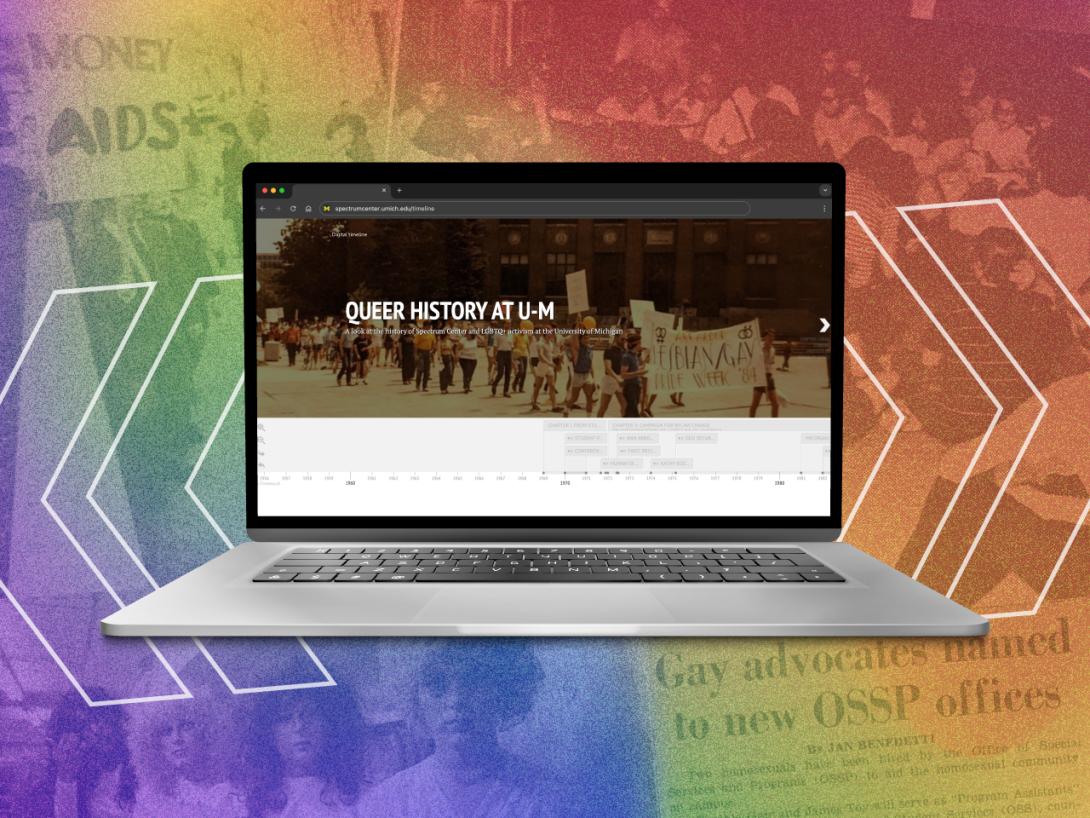June 28, 2024 | By Nick Pfost
Amid American social and political upheaval in the late 1960s and early 1970s, the rise of the Gay Liberation Movement—sparked by the historic Stonewall Riots—emerged alongside growing opposition to the Vietnam War and the ongoing struggle for racial equality and civil rights. At the University of Michigan, the Gay Liberation Front, Women's Liberation Movement, and Black Action Movement organized protests and strikes, demanding increased support for minority students and greater diversity from the university.
An enduring legacy of this courageous student activism and protest, U-M’s Human Sexuality Office—now Spectrum Center—was established in 1971, becoming the first campus-based office dedicated to “gay and lesbian concerns.”
In the 50+ years since, the office has grown and evolved with generations of students who have traveled the campus sidewalks, called for change, and cared for their communities. Today, it stands among 300+ similar offices and centers at colleges worldwide. Now, you can explore key moments along the way, from advocacy to action, policies to people, and queer conferences to court cases.
Take a tour through time—view photos, watch videos, and explore queer history at U-M in our new interactive timeline.
Queer history is our history
“I believe we have the responsibility to steward this history and not allow it to be lost,” said Jesse Beal, Spectrum Center’s director.
For most of the last year, doctoral student (now graduate) Ana Popovic worked with Beal to uncover U-M’s queer history from the late 1960s to the present, and curated the findings into a public resource. The resulting timeline surfaces 75 snapshots spanning seven decades, divided into five distinct, color-coded chapters. Together, they highlight major shifts and developments in LGBTQ+ activism, advocacy, and policy at U-M.
The work builds on the center’s tradition of engaging in history-focused projects, including an oral history completed in 2021 to commemorate its 50th anniversary. The interactive timeline places the history of the center and of communities at U-M in conversation with the broader history of LGBTQIA2S+ communities and liberation movements. By presenting campus history alongside key national and state events, it enhances the understanding of both.
“As a PhD candidate wanting to apply my research skills beyond academia, I contacted Jesse about potential graduate intern roles,” Popovic said. “My research centers LGBTQ history, so I was thrilled when Jesse proposed a project that aligned so well with my interests.”
Popovic began conducting research and informational interviews in fall 2023 through an internship funded by Rackham Graduate School. She completed the digital timeline in 2024 when Spectrum Center invited her back as a graduate assistant.
“I wanted to reveal the various sites of knowledge production and resistance that have shaped U-M’s queer history over time, and the center’s role as one of those key sites of change and progress.”
In the process, Popovic also encountered gaps known to many historians. She noted the contrasts between an abundance of source materials from some eras—such as those of beloved co-founder and community leader Jim Toy—and a dearth in others.
To help fill these gaps, she sought key witnesses to those periods, interviewing previous center directors Ronni Sanlo and Will Sherry, as well as Michigan LGBTQ historian Tim Retzloff. This decision fundamentally improved the understanding of the center’s history, and of queer history made at the University of Michigan.
“Their memories and materials were indispensable,” Popovic said.
Harvesting fruits of collective impact
Across interviews, archived materials, news articles, and prior historical work, a simple theme emerged and informed the project’s strategic imperative: change and growth in the community resulted from the collective impact of many people over time, the indispensable roles they played, and the unique moments they met. The timeline needed to reflect this.
“[The] history of Spectrum Center and U-M LGBTQIA2S+ communities is not the story of any individual,” Beal added. While many stories about social movements focus on a few remarkable individuals, what is seen is often merely the tip of the iceberg. “History we uncovered highlights the countless individuals who fought for the rights of queer and trans people across time.”
The vignettes Popovic assembled into the timeline reveal that reality. “There are so many who faced challenges and created change,” she said. “They all pushed things forward, as did pivotal organizations and the anonymous student protestors who you see in photos. Even if we don’t know their names, they’re part of the story. They all moved things along together.”
The project itself was also a microcosm of collective effort. Charged and supported by Beal, Dr. Popovic coordinated and led the work, with fall funding from Rackham Graduate School and participation from past and current center leaders. Key partners included the Bentley Historical Library, Hatcher Library Special Collections, the Ann Arbor District Library, and Student Life's Technology Solutions and Communications, Marketing, and Design teams.
Read more

